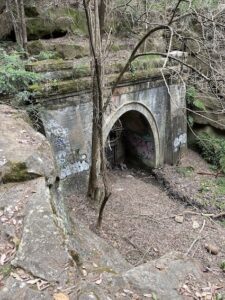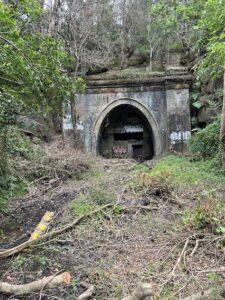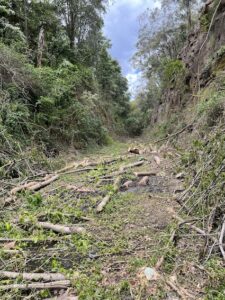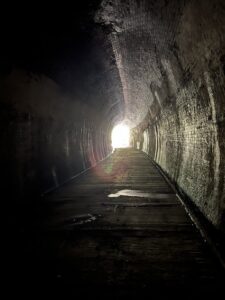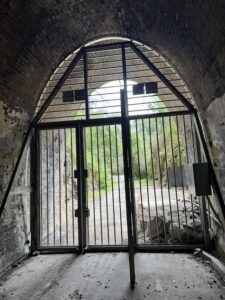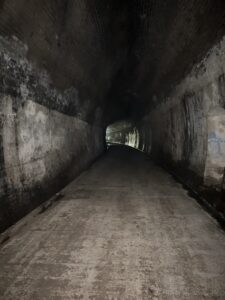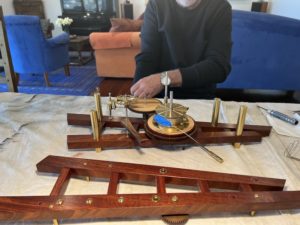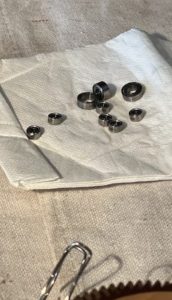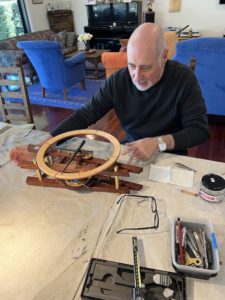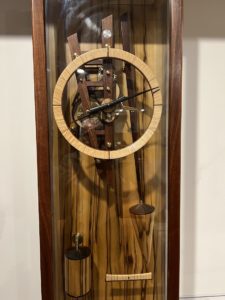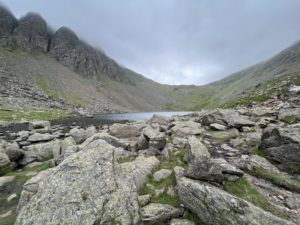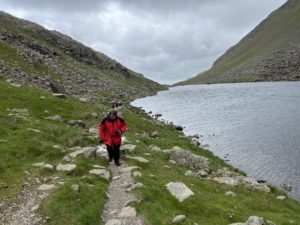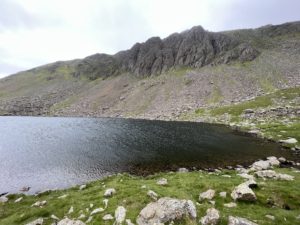Category Archives: 2022 Entries
The first Glenbrook railway tunnel
In my recovery from my recent injury (qv), I have been doing some walking locally. This is one such walk, taking advantage of the fact that I had noticed that the gate blocking entrance to this tunnel had been left open. The tunnel is only about a kilometer from our house, so I took the opportunity to explore its whole length.
The tunnel dates from the late 19th century. The first railway up the initial escarpment of the Blue Mountains involved the use of a zig-zag, which created all the operational difficulties that might be expected. So, as traffic increased, the authorities decided to cut a tunnel up the escarpment instead. This is that tunnel. Given that it was on a gradient (severe, for the steam engines of that era) and S-shaped, which leads to wheel-slip, it was not a success. Within two decades a second deviation was constructed, using a nearby river gully and along the cliff-face thereof. That is the route used today.
So the original tunnel lies unused.
This is the southern/eastern entrance, at the end of a cutting, which until recently was very overgrown, although the council are now clearing it out, as can be seen.
The plan it to create a cycling route from Glenbrook down to Penrith.
Clearly from my viewpoint this is an excellent idea, even if after my most recent bike accident I am going to have to be very careful.
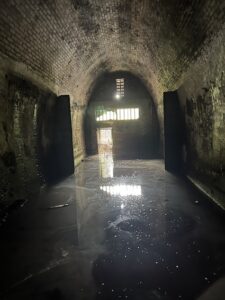 Anyway, I decided to explore the tunnel, previously used for storing RAAF bombs, and subsequently used as a mushroom farm. This is the southern/eastern entrance, seen from within. The water level means that gumboots were needed (I had anticipated this).
Anyway, I decided to explore the tunnel, previously used for storing RAAF bombs, and subsequently used as a mushroom farm. This is the southern/eastern entrance, seen from within. The water level means that gumboots were needed (I had anticipated this).
There is almost nothing left inside. The floor is concreted and the wall brick-lined, so it was very easy to walk up the whole length (a bit less than a kilometer I think), although I couldn’t get out of the northern/western end. The gate there is still locked.
So there you are: an interesting piece of railway history, only a short walk from our house and only requiring a torch and a pair of gumboots to explore.
Protected: Not Quite Local Walks (8)
Protected: Catching up …
Servicing our wooden clock
As some may remember, we have a clock largely ma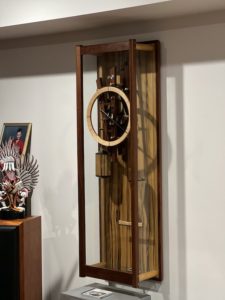 de from native wood. Clearly it is not all wood, having glass, steel wire and brass for the mechanism parts. I have to say that it’s not the easiest clock to read from a distance, but then it’s not so much a clock as a moving piece of artwork! It was made for us some years ago by a master clockmaker near Melbourne, Will Matthysen.
de from native wood. Clearly it is not all wood, having glass, steel wire and brass for the mechanism parts. I have to say that it’s not the easiest clock to read from a distance, but then it’s not so much a clock as a moving piece of artwork! It was made for us some years ago by a master clockmaker near Melbourne, Will Matthysen.
Over the last few months it had become unreliable, stopping sometimes, although the pendulum mechanism meant that when going, it kept reasonable time.
So, on one of his trips to NSW, Will came to our house and services our clock. 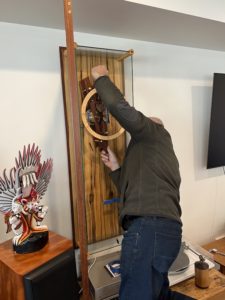
Fundamentally what that meant was to take the clock apart, clean all the moving parts of the dried-out lubrication and accumulated grime, then reassemble the mechanism.
Fascinating to watch. The face, hands and mechanism can be removed from the case (in fact this could be done with the case still on the wall).
It is all then taken apart. All the spindles run in tiny ball races, which have to be removed and cleaned (in “shellite”, whatever that is).
Then it is all reassembled.
It now runs beautifully of course.
(click for larger view)
Kimberly Cruise 1
I (David) went into work last week (I think it was Thursday – 7th July) and told them that I had booked and paid the deposit on a cruise starting on 21st July ….
Then told them that this was for 2023 !
I’m quite excited about this. We will go to the Kimberleys (NW Australia) and go on a 12-day cruise up the coast of northern West Australia.
Click to enlarge, as always.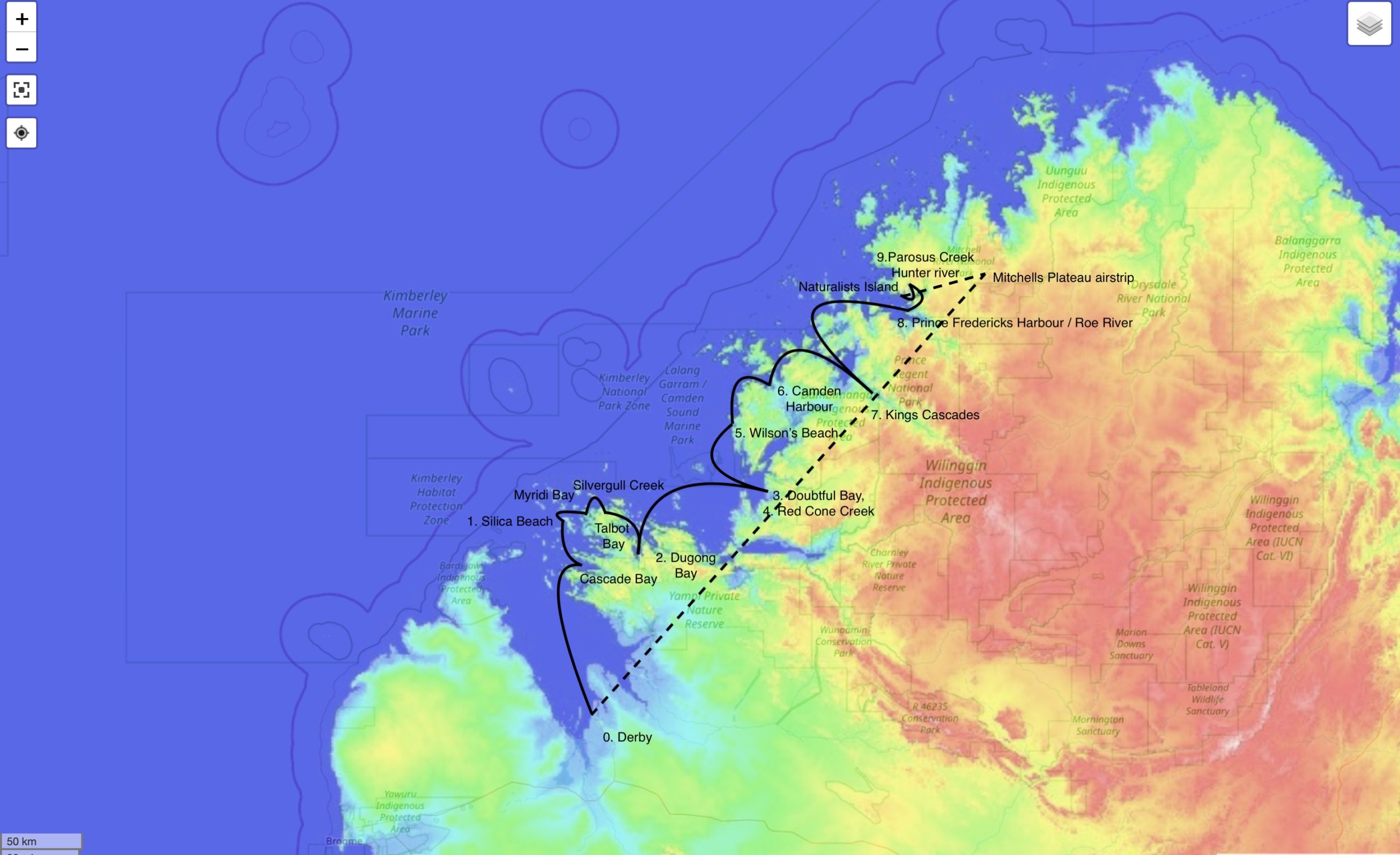
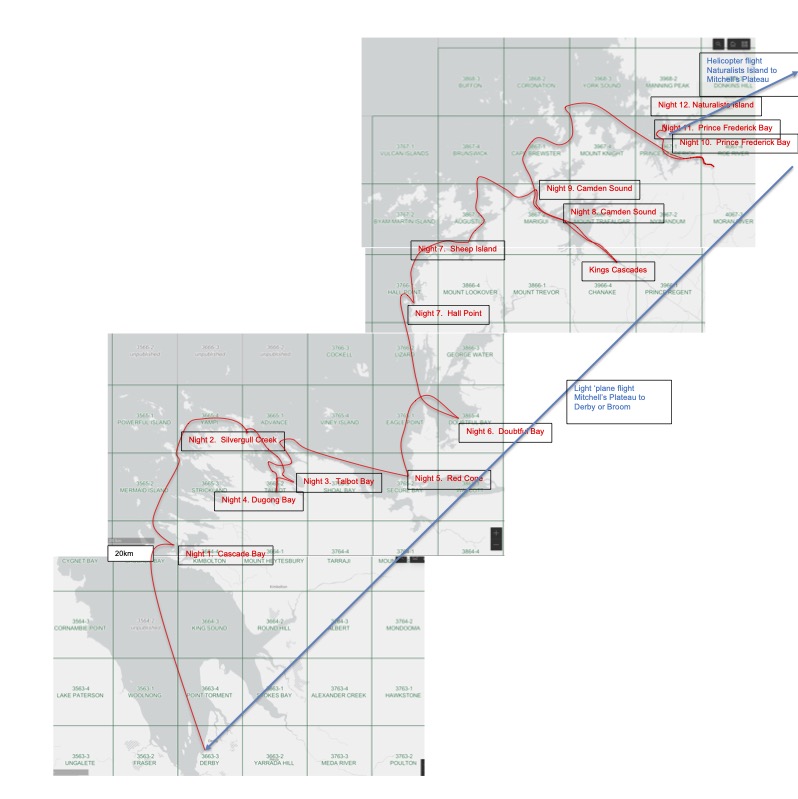 This is the approximate course of the cruise. Our friends Marchelle and Mark went on this tour a couple of years ago, having researched which “cruise” was the best to go on. So we have booked with the same company and boat (it’s called “Discovery One”). A smallish craft – maximum 20 passengers, shallower draught than most boats, two smaller-still rubber “outboards”, emphasis on good food and flexible itinerary according to conditions. What is seen depends on what conditions are like, and what the captain thinks is best. However the rock formations, bays, beaches, birds, fish, crocodiles are all spectacular.
This is the approximate course of the cruise. Our friends Marchelle and Mark went on this tour a couple of years ago, having researched which “cruise” was the best to go on. So we have booked with the same company and boat (it’s called “Discovery One”). A smallish craft – maximum 20 passengers, shallower draught than most boats, two smaller-still rubber “outboards”, emphasis on good food and flexible itinerary according to conditions. What is seen depends on what conditions are like, and what the captain thinks is best. However the rock formations, bays, beaches, birds, fish, crocodiles are all spectacular.
So, I’m excited at the prospect.
Protected: Rain
England June ’22
I went to Manchester earlier this month,then went up to Cark for abut a week.
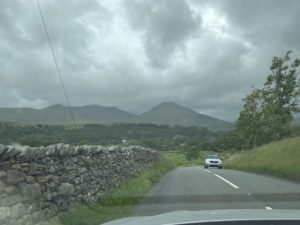 I invited any of my friends who could make it to come up to Mark’s and John’s house there.
I invited any of my friends who could make it to come up to Mark’s and John’s house there.
To the right is an evocative view (evocative for me, anyway) on the road up the west side of Coniston towards the Old Man.
So we set off up the Walna Scar Road towards Seathwaite. Fortunately although it was fine when we had left Cark, I had remembered this was England, and took my waterproofs with me.
By the time we reached Walna Scar it was raining. We turned up to get to Goats Water, below Dow Crag, and then walked around the tarn, rather than climbing up any further because the low clouds meant that we would have seen nothing for higher up the hillsides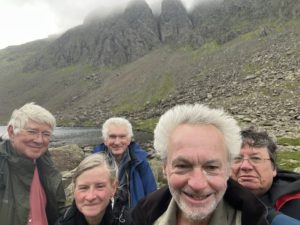
This the walking party at Goats Water.
Walking around the tarn.
Dow Crag, visible above the tarn. At this point, NOT covered in cloud.
It remained dry as we walked down the mountain, but it had definitely been a good decision not to attempt a ridge-walk.
A good day out and a great Lake District walk.

